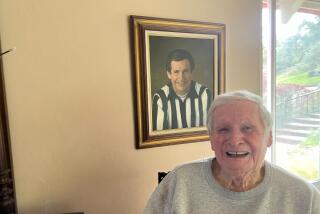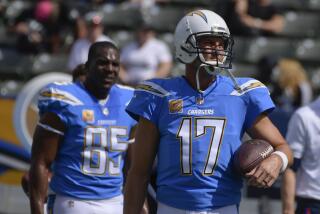Quarterbacks Didn’t Come Any Tougher
Of the players I’ve watched in 66 years of writing about football, Johnny Unitas, who died Wednesday at 69, was the best all-around quarterback and the smartest signal-caller as well as the closest thing to self-made of any of pro football’s 216 Hall of Famers and-- above all--the toughest athlete.
As another Hall of Famer, Merlin Olsen, said one day several years ago when we were talking about Unitas and the role of courage in competitive sports: “He’s the bravest man I’ve known in football.”
Hardly huge for an NFL star, Unitas, who stood 6 feet 1 and weighed 195 pounds, played many games over many years against Olsen, a 6-5 defensive tackle who usually weighed at least 275.
Both excelled in their specialties, passing and pass-rushing, yet neither ever feared the other. Said Olsen: “Out of the corner of his eye, Unitas may see you coming, and I swear that when he does, he holds that ball a split second longer than he really needs to--just to let you know he isn’t afraid of any man. Then he throws it on the button.”
On the button indeed. Or shoe-level if that seemed better. Or high or wide--whatever worked. As a passer, Unitas wasn’t the best of the NFL’s many quarterbacks, past or present--the best was Joe Namath, I’d say, with Sammy Baugh next--but no passer has ever surpassed Unitas in feel for getting the ball away and getting it wherever it had to be for a completion.
It was his passionate interest in completions regardless of any adversity--any troubles such as unexpected double coverage or the kill-the-quarterback rush of Deacon Jones and Olsen--that led Unitas to invent a pass that was to become a game-plan staple everywhere in the league then and now: the so-called comebacker.
Jones and Olsen played side by side on the defensive line of the Los Angeles Rams the year that Unitas, the leader of the two-time NFL-champion Baltimore Colts, came up with the comebacker. There are sports fans who, when they see it today, still say, “That pass was underthrown.” And when Unitas first threw one to a wide receiver sprinting backward instead of forward, everybody thought the ball was underthrown, including every opposing coach and player. As he reported later, Unitas, who also invented, among other passes, the so-called fade, was simply hunting for a place where Hall of Fame teammate Raymond Berry could get the ball in something like peace, away from the choking coverage he saw in every game.
A wide receiver, Berry, like Unitas, also was self-made. But even if you’re annoyingly nearsighted and painfully crooked-backed, as Berry was, it’s easier to make yourself into a respectable receiver than an NFL passer.
“No position in any sport is remotely as hard to play,” Olsen said. “NFL quarterbacks are the greatest athletes in America.”
The first NFL game Unitas played was an exhibition in Portland, Ore., where he wasn’t much. His first employers, the Pittsburgh Steelers, rated him so low on the scale of what they wanted that they cut him.
I was there that summer night in Portland, and I remember that the Rams who had faced him weren’t impressed and weren’t surprised to hear he was gone. In any case, Ram management didn’t pick him up, or even consider it. And, saddening him, no other team would touch him either.
Unitas alone saw Unitas as an All-Pro quarterback. And he joined a sandlot team that year to learn it, the only Hall of Famer who ever did. He spent his first postgraduate season after leaving Louisville playing games on the bottom rungs of the football ladder.
In 1956, however, the Colts found themselves out of quarterbacks. And they needed one more than they needed their pride as a team that would never scour the sandlots for a passer, and by then Unitas had learned to throw spirals.
Neither Unitas nor Baltimore ever regretted their union. He played there from 1956 to 1972, and when the Colts didn’t want him anymore, he caught on with the San Diego Chargers.
In Charger scrimmages he reminded some people not of the Unitas who had played in four NFL championship games, Super Bowls III and V among them, but of the sandlot Unitas.
He was then 40, but he wouldn’t quit. They had to throw him out. That spirit, that unwavering perseverance, is what made him what he was. What’s so admirable about hitting a home run one day and retiring the next, as Ted Williams did? Ending one’s career prematurely is the worst way to go, and Unitas wouldn’t think of it.
What he thought about instead, in an era when players and not coaches called the plays, was how to improve his signal-calling and so compensate for advancing age or anything else. Increasingly throughout his 18 NFL years, in truth, the question about Unitas was whether he was winning with his arm or his head. Some of us rank him as the wisest strategist the NFL had, player or coach, before Bill Walsh built the San Francisco 49er club that won a record five Super Bowls.
And it was harder for Unitas to call good plays than Walsh. Before and after every call, Unitas got knocked around, interrupting his concentration, you’d think. But it didn’t.
As Merlin Olsen said long ago: “The thing that gives Unitas his concentration is his courage.”
More to Read
Go beyond the scoreboard
Get the latest on L.A.'s teams in the daily Sports Report newsletter.
You may occasionally receive promotional content from the Los Angeles Times.










